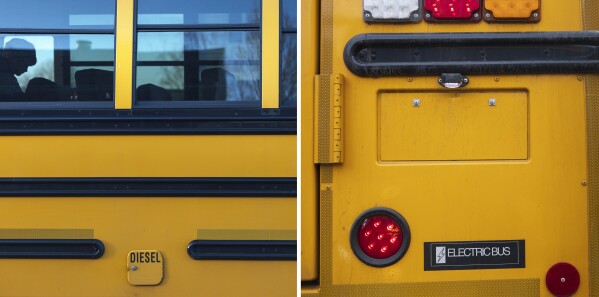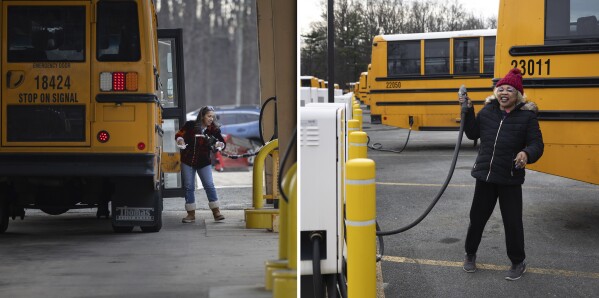[ad_1]
Areli Sanchez’s daughter, Aida, was one of the 20 million American children who traveled on a diesel bus to school every day.
Ada has asthma. She complained about it when she was younger clouds of smell and smoke On his twice daily journey.
“When she would come home from school or be on the bus, she would start having headaches and stomach aches. He said, ‘Mami, I don’t feel good, I’m feeling dizzy,'” Sanchez said in Spanish from Las Vegas. When Ada’s asthma was bad, she would miss class a lot. Research shows exposure to diesel exhaust could harm students miss school And learning is affected.
Sanchez began taking Aida to school after she was hospitalized for an asthma attack in the second grade.
diesel exit According to federal data, school buses potentially impact one-third of American students, their parents and teachers every day. This is a known carcinogen It also contains harmful nitrogen oxides, volatile gases and particles. increase lung problems, It also contributes to global warming.
The environmental and health issues most affected by these are Black, Latino, Indigenous and low-income communitiesThey often rely on buses to get to school and are also more likely to suffer from asthma than other students. Some of the biggest drivers of change are parents concerned about their children.
Things continued to get worse for Areli Sanchez’s family in Las Vegas.
He felt as if he had to stop working. “I didn’t know when we would get a call from the school about another asthma attack,” she said.
When his daughter started having problems a few years later, Sanchez saw an opportunity to join the emerging movement for electric buses, They do not smell. They are not noisy. They cost more up front, but cost less to run and can significantly reduce emissions, making them a climate change solution.
Now Sanchez has been making the case locally and beyond for four years, even taking long diesel bus trips to the state capital, Carson City, to plead for funding from the legislature.
Recently they started to get some traction when their district, Clark County School District, started replacing some of their buses with electric buses. These still make up only a fraction of the roughly 2,000 in the fleet, but he’s optimistic.
somewhat similar Progress is being made across the country There is a sense of urgency around environmental injustices related to deteriorating air quality and a warming climate.
Sara Adar, an epidemiology and public health researcher at the University of Michigan who studies the relationship between health and exposure, said children are generally harmed more by air pollution than adults because their bodies are still developing. are, and because they breathe more air per body size than adults. School buses.
“As they’re burning their fuel and as the engine is spinning, they’re often releasing very, very small particles that can go deep into our lungs and wreak havoc throughout the body,” Adar said.
Children also may spend a lot of time around idling buses, increasing their exposure to something that could permanently harm their health, she said. Research highlights poor air quality Inside old diesel school busesVery.
“It’s a perpetual cycle of poor air quality,” said Lonnie Portis, policy and advocacy manager for the activist group We Act for Environmental Justice in New York City. In hard-hit, or environmental justice neighborhoods, he said, “you’re eliminating at least some of that by putting electric school buses into rotation.”
Some school districts have adopted new versions of diesel buses, which are more efficient and produce less pollution, as a way to reduce exposure to students. Others, especially in less funded districts, keep their older, more polluting vehicles.
Like Sanchez, Liz Hurtado, a mother of four who rides the bus in Virginia Beach, Virginia, has spent years advocating for electric buses.
Her eldest daughter also had a headache driving the diesel bus, she said, and she took it to school whenever possible.
Now a national field manager for the grassroots group Moms Clean Air Force and active in a program dedicated to protecting the health of Latino children, Hurtado has appealed to school districts to purchase electric buses. She schedules events for community members to see and drive electric vehicles, hosts webinars and meetings and teaches others how to reach legislators.
“Knowing all the stress and anxiety that comes with climate change and the fact that it’s a huge burden for our children,” Hurtado said. “It burdens us, doesn’t it?”
Although an electric bus is not available to her yet, she feels “really excited about the speed”.
Federal money is now the major source of funding for electric school buses, and prioritizes low-income, rural or tribal communities, which supporters see as a big win. According to WRI, most of the electric school buses on the road today have landed in those areas.
“It means we’re putting the solution closest to the problem,” said Carolina Chacon, coalition manager for the Alliance for Electric School Buses, a group of nonprofits that is expanding.
Sanchez said Aida will not be able to benefit from electric buses because she is now 16 years old.
“But other moms won’t have to worry like I do because of the smoke,” she said.
,
Alexa St. John is an Associated Press climate solutions reporter. Follow him on X, formerly Twitter, @alexa_stjohn, reach it ast.john@ap.org,
,
The Associated Press’ climate and environmental coverage receives financial support from several private foundations. AP is solely responsible for all content. find api standards A list of philanthropies to work with, supporters and funded coverage areas ap.org,
[ad_2]
Source link




